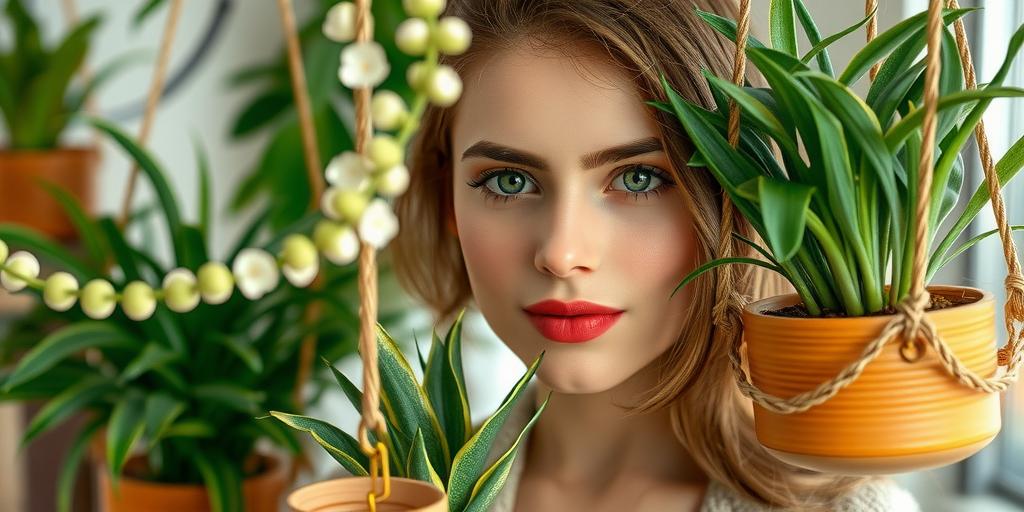
Unique Low Light Hanging Plants with Eye-Catching Foliage for Stunning Indoor Spaces
Discover the best unique low light hanging plants with stunning foliage to brighten up dim corners! Perfect for beginners and plant lovers alike—easy care, high impact.
Introduction
Did you know that low-light plants can thrive even in the darkest corners of your home? If you’re looking to add lush greenery without needing direct sunlight, hanging plants are the perfect solution! From cascading vines to striking variegated leaves, these unique low light hanging plants bring life to any space—whether it’s a cozy apartment, office, or bathroom. In this guide, we’ll explore the best varieties, care tips, and creative ways to display them. Let’s dive in!
Why Choose Low Light Hanging Plants?
Perfect for Spaces with Minimal Natural Light
Not every room in your home gets abundant sunlight, but that doesn’t mean you can’t enjoy lush greenery. Low light hanging plants thrive in dimmer corners, hallways, or north-facing rooms where other plants might struggle. They’re the perfect solution for brightening up those tricky spots that need a little life.
Ideal for Busy Plant Parents
If you’re someone who forgets to water plants or travels often, many low light hanging varieties are forgiving and low-maintenance. Plants like Pothos and Spider Plants can handle occasional neglect and still look stunning. No need to stress—these plants have your back.
Add Vertical Interest and Maximize Small Spaces
Hanging plants are a game-changer for small apartments or rooms with limited floor space. By growing upward or cascading down, they draw the eye upward, making ceilings feel higher and rooms feel more spacious. Plus, they add a dynamic, layered look to your décor.
Improve Air Quality and Boost Mood
Many low light hanging plants, like Spider Plants and Philodendrons, are natural air purifiers, filtering out toxins and increasing oxygen levels. Beyond their health benefits, their lush foliage has a calming effect, helping to reduce stress and create a more inviting atmosphere.
Top Unique Low Light Hanging Plants with Stunning Foliage
Pothos (Epipremnum aureum)
Pothos is a classic for a reason—it’s nearly indestructible. With heart-shaped leaves that come in shades of green, gold, or marble, it thrives in low light and can survive occasional missed waterings. Let it trail from a shelf or hang in a macramé planter for effortless charm.
String of Hearts (Ceropegia woodii)
This delicate beauty features slender vines dotted with small, heart-shaped leaves that often have a soft pink hue. It grows slowly but steadily, making it perfect for a whimsical, fairy-like display. Just give it bright indirect light (though it tolerates low light well) and let it drape elegantly.
Spider Plant (Chlorophytum comosum)
With arching green and white striped leaves, Spider Plants are as hardy as they are attractive. They produce tiny “spiderettes” (baby plants) that dangle from the mother plant, adding extra visual interest. Great for beginners and pet-friendly too!
Peperomia ‘Hope’
This compact trailing plant has thick, succulent-like leaves that store water, making it drought-tolerant. Its rounded foliage grows in clusters, creating a lush, cascading effect. It’s perfect for small hanging planters and thrives in moderate to low light.
Philodendron Micans
If you love velvety textures, Philodendron Micans is a must. Its iridescent leaves shimmer in low light, shifting between deep green and bronze. It’s a fast grower, so you’ll quickly have long, trailing vines that add a touch of elegance to any space.
How to Care for Low Light Hanging Plants
Watering: Less Is More
Overwatering is the #1 killer of houseplants. Most low light hanging plants prefer their soil to dry slightly between waterings. Stick your finger an inch into the soil—if it’s dry, it’s time to water. If it’s still damp, wait a few more days.
Light Needs: Bright Indirect to Low Light
While these plants tolerate low light, they’ll grow best in bright indirect light. Avoid direct sun, which can scorch their leaves. If your plant starts looking leggy or pale, try moving it closer to a window (but still out of harsh sunlight).
Humidity: Average Indoor Levels Are Fine
Most low light hanging plants adapt well to typical home humidity. However, if your air is very dry (especially in winter), occasional misting or a pebble tray can help. Philodendron Micans and Peperomia ‘Hope’ especially appreciate a little extra moisture.
Fertilizing: Light Feeding in Growing Season
During spring and summer, a diluted liquid fertilizer every 4-6 weeks will keep your plants happy. Skip fertilizing in fall and winter when growth slows down. Over-fertilizing can lead to salt buildup, so less is more.
Creative Ways to Display Hanging Plants
Macramé Hangers for a Boho-Chic Look
Nothing says “plant lover” like a beautifully knotted macramé hanger. These add texture and warmth while showcasing your trailing plants. Hang them near windows or in empty corners for an instant style upgrade.
Wall-Mounted Shelves with Trailing Plants
Install floating shelves and let your plants spill over the edges. Mix different varieties like Pothos and String of Hearts for a lush, layered effect. This works especially well in small spaces where floor space is limited.
Ceiling Hooks in Kitchens or Bathrooms
Take advantage of vertical space by hanging plants from ceiling hooks. Kitchens and bathrooms often have higher humidity, making them great spots for moisture-loving plants like Philodendrons.
Tiered Plant Stands for a Lush Effect
A multi-level plant stand allows you to arrange hanging and potted plants together, creating depth and dimension. Place it near a window or in a dim corner to turn it into a mini indoor jungle.
Common Problems & Solutions
Yellow Leaves? Check Your Watering
If leaves turn yellow, you might be overwatering. Let the soil dry out more between waterings and ensure your pot has drainage holes. On the flip side, if leaves are crispy, your plant might need more water.
Leggy Growth? Adjust Light
Long, sparse stems mean your plant is stretching for more light. Move it to a slightly brighter spot (but still no direct sun) to encourage fuller growth. You can also trim leggy vines to promote bushiness.
Pests? Treat Early
Spider mites, mealybugs, and aphids can sometimes appear. Wipe leaves with a damp cloth or treat with neem oil or insecticidal soap. Isolate affected plants to prevent pests from spreading. Regularly inspecting leaves helps catch issues early.
Conclusion
Low light hanging plants are the ultimate way to add greenery to any dim space—no green thumb required! With their eye-catching foliage and easy-care nature, they’re perfect for beginners and seasoned plant lovers alike. Ready to transform your home? Pick your favorite from our list and start hanging!
